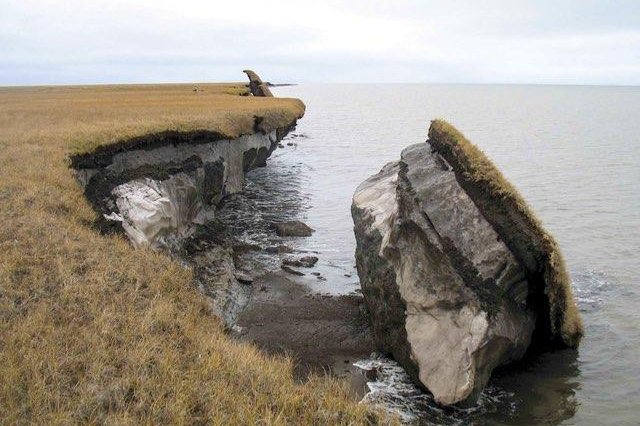A block of ice-rich permafrost collapses into the ocean along Drew Point, Alaska. Coastal bluffs in this region can erode 65 feet per year. Photo by Benjamin Jones/USGS
April 21 (UPI) -- The 2015 Paris agreement to limit greenhouse gas emissions may not prevent as much as half of the permanently frozen soils at the Earth's highest latitudes from thawing, according to a new study.
Newly published research in the journal Nature Climate Change, offers what may be the most realistic estimate to date of how much of the Northern Hemisphere's 5.79 million square miles of permafrost would be lost as the average global temperature continues to rise in coming decades and centuries.
Such a thaw would dramatically alter the High North's environment, as evident by buildings already sinking into the tundra and coastlines slumping into the sea. It would also release many tons of additional carbon into the atmosphere, further accelerating climate change worldwide. The estimated losses are about 20 percent greater than predicted by previous climate modeling.
"People have looked at what's going to happen to permafrost in the future before, but no one's really put it in terms of [the] stabilization targets we have for the Paris Agreement," said S.E. Chadburn, the study's lead author and a climate scientist at the University of Leeds and the University of Exeter.
If nations succeed in limiting average temperature increase to 2 C, or 3.6 F, Chadburn and her colleagues forecast that 2.3 million to 3.9 million square miles of permafrost will be lost, or 3 to 5 million square kilometers per degree.
If temperatures rise by an average 1.5 C, acknowledged as the Paris treaty's more desirable target, then the loss might be reduced by 20 percent, according to the study.
The wide range of possibilities reflects uncertainties about how much snow cover there may be in the future, as well as the thermal properties of frozen and thawing ground, Chadburn said. Also unknown is whether the High North will continue warming at roughly twice the rate of the rest of the planet – the phenomenon called "Arctic amplification."
To devise an estimate of how much permafrost would be lost per degree of temperature rise, Chadburn and colleagues began with maps of permafrost developed between 1960 and 1990. "We took the observed air temperatures from the same time period that the map was made, and then we fitted the relationship between the air temperatures and the permafrost," Chadburn said. "Then we used that same relationship to extrapolate to some future air temperatures," and ran those data through several climate models and greenhouse gas emissions scenarios to calculate how much permafrost would thaw.
Human activities have already driven the average global temperature almost 1 degree above pre-industrial norms, and scientists increasingly agree that 1.5 degrees of change is "locked in," as the climate continues to respond to both past and ongoing greenhouse gas pollution. The ground is already shifting under some Arctic communities built on what was once permafrost, such as Fairbanks, Alaska, where sinkholes and groundwater flooding have become visible symptoms of the planet's warming trend.
A 2015 study, also published in Nature Climate Change, forecasts global economic losses from melting permafrost at $43 trillion over the next 200 years, in part because permafrost itself contains 1.7 trillion tons of carbon, twice as much as what's currently in the atmosphere.
Under their best-case scenario, Chadburn and colleagues predict an all-but-inevitable loss of 0.4 million to 2.2 million square miles of permafrost. Taken together with the numbers from the 2015 study (which was the work of a different team of researchers), that could add anywhere from 125 billion to 635 billion tons of carbon to the atmosphere by 2200.
Estimates of carbon emissions from permafrost weren't accounted for in the Paris climate treaty, but could shave years' to decades' worth of greenhouse gas pollution off humanity's remaining carbon budget – the amount of CO2 that can be further emitted before triggering catastrophic climate change.
"To know how much carbon dioxide or methane will be emitted [from permafrost], you need to know how quickly the carbon in the soil is decomposing, or how quickly the organic matter is decomposing, and that depends on the microbes in the soil," a biological process that is difficult to model, says Chadburn. "How much of it will come out and how quickly is really not well understood."
Emily Gertz is a freelance American journalist. This article originally appeared on Arctic Deeply, and you can find the original here. For important news about Arctic geopolitics, economy, and ecology, you can sign up to the Arctic Deeply email list.















